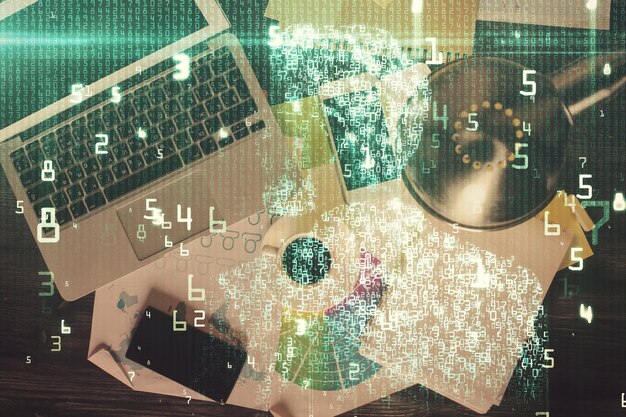NSA and Allies Unite: Best Practices for Event Logging Revealed
In today’s digital world, where cyber threats are becoming increasingly sophisticated and frequent, effective event logging has never been more critical for organizations seeking to safeguard their systems and maintain regulatory compliance. In this context, insights from the National Security Agency (NSA) and its global allies on best practices for event logging can be invaluable.
Why Event Logging Matters
Event logging refers to the process of recording and maintaining detailed records of actions taken on computer systems and networks. These logs serve as a critical source of information for incident response, forensic analysis, and compliance reporting. With the right tools and practices in place, event logging can help organizations detect and respond to cyber threats more effectively.
Insights from the NSA and Allies
The NSA and its international partners have long recognized the importance of event logging in maintaining cybersecurity. They emphasize that event logs should be centrally collected, indexed, and analyzed to enable effective threat detection and response.
Centralized Collection
To achieve centralized collection, NSA recommends implementing a Security Information and Event Management (SIEM) system. This allows for the consolidation of event data from multiple sources into a single platform, making it easier to analyze and correlate events.
Effective Indexing
Proper indexing of event logs is crucial to enable efficient querying and analysis. NSA suggests using structured data formats such as Common Security Event Format (CSEF) or Common Event Expression (CEE) to facilitate indexing and correlation.
Analysis and Correlation
NSA emphasizes the importance of analyzing event logs in real-time to identify potential threats. This can be achieved through automated correlation rules or machine learning algorithms that help uncover anomalous behavior.
Best Practices for Event Logging
Some additional best practices for event logging, as recommended by NSA and its allies, include:
Retention
Event logs should be retained for a sufficient period to enable comprehensive analysis and regulatory compliance. The length of retention will vary depending on the organization’s specific requirements.
Secure Storage
Event logs should be stored securely to prevent unauthorized access and ensure the integrity of the data. Encryption, access controls, and regular backups are essential components of a robust event logging solution.
Integration with Incident Response
Event logs should be easily accessible to incident response teams during investigations. Integrating event logging with an incident response platform can help streamline the process and improve overall security posture.
Conclusion
In conclusion, event logging plays a vital role in modern cybersecurity and regulatory compliance. The insights shared by the NSA and its global allies provide valuable guidance for organizations seeking to optimize their event logging practices.
Further Reading
For more information on event logging best practices, we recommend checking out the following resources:
Exploring the Crucial Role of Event Logging in Cybersecurity
Event logging, the process of recording and storing
digital events
or system activities in a
secure and centralized manner
, plays a pivotal role in the realm of cybersecurity. It serves as an essential tool for detecting, investigating, and responding to
cyber attacks
and
data breaches
. In the ever-evolving cyber threat landscape,
high-profile incidents
such as the SolarWinds supply chain attack, the Colonial Pipeline ransomware attack, and the JBS Foods ransomware attack have dramatically underscored the necessity of effective event logging practices.
Recently, the
National Security Agency (NSA)
and its allies have recognized this need for collaboration in the cybersecurity space. They have announced a new initiative to share best practices related to event logging and analysis among their respective organizations. This
international partnership
aims to strengthen the collective cybersecurity posture and bolster defenses against potential threats. By pooling their resources, knowledge, and expertise, these organizations hope to promote a more robust event logging culture, ultimately contributing to a more secure digital world.
Background:
NSA: The National Security Agency (NSA) is a
Event Logging in Organizations
Event logging is a crucial component of any cybersecurity strategy. It involves documenting and analyzing the activities that occur within an organization’s IT infrastructure. This data can help identify, investigate, and prevent potential security threats. Many organizations employ event logging solutions to maintain a record of system events, user activities, and other relevant data.
Current State
Despite the importance of event logging, many organizations struggle with implementing effective practices. A link indicates that only 61% of US companies have a dedicated security incident response team. This lack of resources and expertise can lead to inadequate event logging processes, making it challenging for organizations to detect and respond to threats promptly.
Challenges
There are several challenges that security teams face when implementing effective event logging practices:
- Volume: The sheer amount of data generated by event logging systems can be overwhelming, making it difficult to parse and analyze relevant information.
- Complexity: Event logs from various systems and applications can be challenging to integrate and correlate, making it difficult to derive meaningful insights.
- Cost: Implementing and maintaining robust event logging solutions can be expensive, especially for smaller organizations with limited budgets.
I Collaboration Announcement
In a groundbreaking move towards enhancing global cybersecurity, the National Security Agency (NSA) recently announced a new collaboration with its international allies. This partnership, aimed at strengthening cyberdefenses against advanced persistent threats (APTs) and other malicious actors, is expected to bring significant improvements in the field.
Objectives of the Partnership
The primary objective of this collaboration is to share intelligence, best practices, and resources among its members. By pooling their collective expertise and capabilities, the alliance aims to:
- Improve threat intelligence: Members will collaborate on analyzing and responding to threats in real-time.
- Enhance incident response: The group aims to streamline the process of identifying, containing, and mitigating cyberattacks.
- Promote cybersecurity awareness: The alliance will work towards increasing awareness and education within their respective communities.
- Develop countermeasures: Members will collaborate on researching and developing advanced security solutions to counteract evolving threats.
How the Collaboration Came About
This partnership came about as a result of increased awareness regarding the growing sophistication and scale of cyber threats. Several high-profile incidents, including the SolarWinds hack and the Microsoft Exchange Server vulnerability, served as catalysts for this initiative. Recognizing that no single organization could effectively tackle these threats alone, various intelligence agencies and cybersecurity experts came together to form this alliance.
A Response to Evolving Threats
This collaboration represents a significant response to the evolving threat landscape. As cybercrime continues to grow in sophistication and scale, it is essential that organizations and governments work together to protect their digital infrastructure. By sharing knowledge, resources, and expertise, this alliance is poised to make a substantial impact on the cybersecurity landscape.
Conclusion
The NSA’s collaboration with its allies marks an important milestone in the ongoing battle against cyber threats. By pooling their collective efforts, this alliance is set to improve threat intelligence, enhance incident response, promote cybersecurity awareness, and develop countermeasures. Only time will tell how successful this initiative will be in the face of ever-evolving threats. However, one thing is certain: collaboration is key to staying ahead of the curve in the world of cybersecurity.
Shared Best Practices for Event Logging
Standardizing event logging formats
Standardizing event logging formats is a crucial aspect of maintaining effective IT security and compliance. However, achieving a uniform approach across various systems and applications can be a challenging task. Different organizations employ diverse logging methods, making it difficult to consolidate and analyze logs efficiently. Some common challenges include:
Variations in log structures:
Logs may differ significantly in their format, including fields and their order, making it challenging to parse them uniformly.
Lack of standardized semantics:
Each system may use unique event codes and descriptions, which can hinder understanding the meaning behind log entries.
Log volume and diversity:
Large volumes of logs from different sources can complicate the process, making it difficult to filter out relevant data for analysis.
Description of common challenges in standardizing event logs across different systems and applications
The absence of a standardized approach to event logging creates several challenges. Organizations face difficulties in:
Analyzing and correlating log data:
Disparate formats and semantics make it challenging to identify patterns, trends, or anomalous behaviors.
Integrating log data into security tools:
Security solutions, such as SIEM (Security Information and Event Management) systems, struggle to process logs that don’t adhere to a unified format.
Maintaining compliance:
Different regulations and industry standards require specific logging practices, making it essential to adapt to various formats.
Explanation of the benefits of using a unified format
Standardizing event logs comes with numerous advantages:
Improved analysis and correlation:
Uniform formats make it easier to identify patterns, trends, or anomalous behaviors.
Enhanced security:
SIEM and other security solutions can process logs more efficiently, allowing for quicker threat detection and response.
Easier compliance:
Adhering to a standardized format can simplify the process of meeting various regulatory requirements.
Mention of specific standards being advocated by the NSA and its allies
To address these challenges, organizations and international security agencies advocate for standardized event logging formats like Common Security Language (CSL). CSL provides a consistent framework for defining, formatting, and exchanging security-related data among various systems. By adopting such standards, organizations can improve their security posture while simplifying log management and analysis.
Implementing Centralized Log Management:
Centralized log management is a crucial aspect of modern IT infrastructure, offering numerous benefits that help organizations streamline and improve their event logging practices. By collecting, aggregating, and analyzing log data from various sources across an organization, centralized log management systems enable IT teams to gain valuable insights into system performance, identify security threats, and ensure regulatory compliance.
Benefits of Centralized Log Management:
Some of the key advantages of implementing a centralized log management system include:
- Improved visibility: Centralized logging allows IT teams to monitor all systems and applications from a single location, providing a holistic view of an organization’s IT environment.
- Enhanced security: Centralized logging makes it easier to detect and respond to security threats by analyzing log data from multiple sources in real-time.
- Compliance with regulations: Centralized logging helps organizations meet regulatory requirements by providing a central repository for log data.
- Reduced costs: By consolidating log management across an organization, IT teams can save time and resources that would otherwise be spent on managing multiple disparate logging solutions.
How Centralized Log Management Helps:
Centralized log management helps organizations by:
- Simplifying log collection and aggregation: Log data from multiple systems and applications is sent to a centralized location, making it easier for IT teams to access and analyze the data.
- Providing real-time analysis: Centralized log management systems enable IT teams to analyze log data in real-time, allowing them to quickly identify and respond to security threats or system issues.
- Facilitating compliance: Centralized log management makes it easier for organizations to meet regulatory requirements by providing a central repository for log data and enabling easy access to the data for auditing purposes.
- Enhancing incident response: Centralized log management enables IT teams to respond more effectively to incidents by providing a single source of truth for log data across an organization.
Examples of Successful Centralized Log Management Implementations:
Many organizations across various industries have successfully implemented centralized log management systems, including:
- Financial Services: Major financial institutions use centralized log management to meet regulatory requirements and ensure the security of their customers’ data.
- Healthcare: Hospitals and healthcare organizations use centralized log management to monitor patient data, meet regulatory requirements, and ensure the security of their systems.
- Retail: Retailers use centralized log management to monitor their Point-of-Sale (POS) systems, detect and respond to security threats, and ensure compliance with industry standards.
Establishing Effective Log Retention Policies
Log retention refers to the practice of storing and managing event logs generated by IT systems, applications, and security devices. These logs serve as invaluable resources for incident response and forensic analysis, providing critical information about system activity, potential threats, and vulnerabilities. With the increasing complexity of IT environments and the frequency of cyber attacks, effective log retention policies have become essential for organizations to protect their digital assets.
Importance of Log Retention
Incident Response: Logs enable security teams to investigate and respond to incidents in a timely and effective manner. They provide context, detail, and evidence that can help identify the root cause of an incident, assess its impact, and implement remediation measures.
Forensic Analysis: Logs are also crucial for post-incident analysis and digital forensics. They offer a detailed record of system activity, which can be used to reconstruct events leading up to an attack or data breach. This information is essential for understanding the tactics, techniques, and procedures (TTPs) used by adversaries, improving security defenses, and preventing future attacks.
Best Practices for Defining a Log Retention Policy
Minimum Required Duration: Organizations should establish a minimum required log retention duration based on their risk profile, regulatory compliance requirements, and incident response needs. Generally, logs related to security events and potential threats should be retained for a longer period, such as six months to a year or more.
Data Protection Considerations:
Secure Storage: Logs contain sensitive information and should be stored securely. Access to log data should be restricted, and strong encryption should be used for both at-rest and in-transit storage.
Backup and Redundancy: Organizations should maintain backups of their log data to ensure availability in case of data loss or corruption. Redundant copies can be stored offsite or in the cloud to provide additional protection and enable rapid recovery.
Monitoring and Analysis: Log data should be regularly monitored and analyzed to detect anomalous activity, identify potential threats, and respond to incidents promptly. Implementing automated tools and processes can help streamline log analysis and improve security efficiency.
Ensuring Proper Access Control and Monitoring
Access control and monitoring are crucial aspects of maintaining the security and integrity of any system or network. Among these areas, controlling
Best Practices for Access Control
Role-Based Access Control (RBAC)
- Assigning access levels based on roles and responsibilities
- Simplifying administration by centralizing control
- Reducing the risk of human error through predefined access policies
Two-Factor Authentication (2FA)
- Requiring users to provide two forms of identification
- Adding an extra layer of security to logins and access attempts
- Deterring unauthorized access through additional authentication steps
Monitoring and Auditing Log Access
Monitoring event logs and auditing log access is essential for detecting unauthorized activities. Some methods to implement include:
Real-Time Alerts
- Setting up alerts for suspicious activities as they occur
- Reacting quickly to potential threats to minimize damage
- Utilizing automated systems for efficient threat detection
Log Analysis
- Reviewing logs for trends, anomalies, and patterns
- Using tools to process large amounts of data efficiently
- Correlating events from multiple logs for a comprehensive view of system activity
Regular Reporting and Review
- Generating reports on system activity for analysis and trending
- Reviewing logs regularly to identify potential issues or threats
- Maintaining a record of log activity for forensic and compliance purposes
Case Studies:
Exploring real-life scenarios of successful event logging implementation in various organizations unveils valuable insights into best practices and their positive outcomes. Let’s delve deeper into a few captivating case studies:
Case Study 1: NASA’s Mars Rovers
NASA’s Mars Rovers, which are spacecrafts designed to explore the Martian surface, generate enormous amounts of data daily. Effective event logging led to the detection of an anomaly in the rover’s power system. The well-documented logs helped engineers identify and address the issue, enabling the rovers to continue their exploration missions uninterrupted.
Case Study 2: Netflix
Netflix, the leading streaming platform, uses real-time event logging extensively to monitor user interactions and ensure high application performance. The company’s focus on robust logging practices led to reduced incident response times, enhancing overall user experience and maintaining customer trust.
Case Study 3: Bank of America
Bank of America‘s cybersecurity team relies on comprehensive event logging to protect against potential threats. By analyzing large volumes of logs, they were able to detect and respond to an attempted data breach in record time, saving the company millions in potential losses.
Conclusion:
Effective event logging practices lead to significant improvements in threat detection, incident response times, and overall operational efficiency. By studying these case studies, we can learn valuable lessons for implementing best practices in our own organizations.
VI. Conclusion
In today’s digital landscape, where cyber threats are increasingly sophisticated and relentless, having an effective event logging strategy has become a cornerstone of robust cybersecurity. In this article, we’ve explored the importance of event logging and its role in detecting and responding to potential security breaches. Firstly, we discussed how event logs provide valuable data that can help organizations gain insights into their network activity and identify anomalous behavior.
Secondly
, we delved into the different types of event logs and their sources, emphasizing the importance of collecting data from various endpoints and applications.
Thirdly, we highlighted the benefits of using standardized event logging formats such as Common Security Event Administration (CSEA) and Security Information and Event Management (SIEM) systems. These tools help streamline the process of collecting, analyzing, and responding to security events.
Fourthly
We also shared some best practices from the NSA and its allies, including implementing a centralized logging architecture, setting up proper retention policies, and ensuring that all logs are protected against unauthorized access. By adopting these practices, organizations can significantly improve their ability to detect and respond to cyber threats.
Lastly, we looked at the future implications and potential advancements in event logging technologies and methodologies. With the rise of artificial intelligence, machine learning, and other advanced analytics techniques, event logs are increasingly being used to power predictive security models that can help organizations proactively detect and respond to threats.
Final Thoughts
As we move forward, it’s essential that organizations continue to invest in and prioritize their event logging strategies. With the ever-evolving threat landscape, having a solid understanding of your network activity and being able to quickly respond to potential threats is more important than ever before. By following the best practices we’ve outlined in this article, organizations can strengthen their cybersecurity posture and better protect themselves against the latest threats.
Sources
National Security Agency. “Security Information and Event Management (SIEM).” link
“Common Security Event Administration (CSEA).” National Cybersecurity Center of Excellence. link






